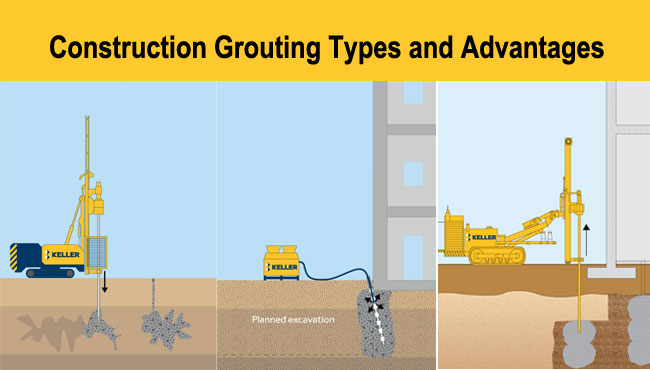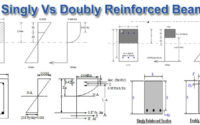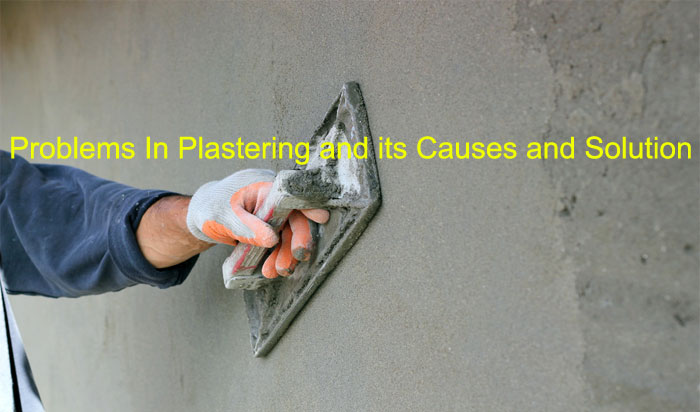What is Grouting | Grouting Types and Advantages
Grout is a fluid-like material that is composed of cement, sand, water, and chemicals. This mixture is used to inject into soil or rock formation for the change of its physical properties by an advanced technique known as Grouting.
Depending on the area, type of soil/rock, materials used for grouting depends.
Let’s discuss about the various types of grouting-
1. Permeation Grouting:
This type of grouting is done by injecting the grout into soil to fill the pores and joints, while the structure and volume of soil remains undisturbed. A cemented mass is created as it permeates granular and coarse soil.
The permeability of soil is responsible for the types of binders to be chosen for this technique. This is known as cement/pressure grouting.
Types of Grout mixtures used-
- Water-cement mixes are used if the coefficient of permeability is greater than 10^-2 cm/sec.
- Resin based grouts that are expensive are used if permeability is lower as 10^-5 cm/sec.
- Soils that are non-permeable by grouting method are those with K value less than 10^-6 cm/sec.
Permeation Grouting Advantage:
- Possible in areas difficult to access, also occurs in limited space.
- Substitutes the alternative methods such as piling, also economical for underpinning applications.
- Compared to piled solution, the footprint of excavations is maximum.
- Next to existing foundation, it can be adopted.
- Performed without normal facility operations being disrupted.
Used for providing barriers to groundwater flow, for underpinning foundations, provides excavation, stabilizes and strengthens granular soils.
2. Compaction Grouting:
In this type of grouting a thick consistent soil-cement grout is injected into the soil mass under pressure which stabilizes the surrounding soil and also consolidates.
The grout mix is composed in such a way that it does not mix with the soil by permeating soil voids rather displaces the soil it is injected to.
Compaction Grouting Advantage:
- Installation time is very short.
- Minimal site vibration is generated.
- Applicable in areas with limited space and difficult access.
- No induced spoils.
- Not connected to existing foundation structure.
- Significantly reduces settling of existing foundation.
- For sinkholes this serves as best fit.
- Accurate pressure provided along with the proper placement of aggregate structure of grout.
- Soil liquefaction potential due to earthquakes gets minimised.
- Compared to other soil stabilisation and ground shoring methods, quite economical.
Although there are certain limitations like this method is not applicable to soils with less permeability such as clay, also it cannot be used where the ground above grouting area has limited overburden.
Used to improve the bearing capacity of soil, decreases and corrects settlements, prevents and repairs sinkholes, best suitable for loose granular soils, reinforce fine grained soils, suitable for ground stabilisation(where pipes and conduits are or will be installed), also used for the ground under settled structures in preparation for lifting them also re-levelling them.
3. Jet Grouting:
A little costly as compared to permeable grouting, this type of grouting is done by using high velocity fluid jet that disrupts the ground physically. During the process, the grout is mixed with the eroded soil thereby improving it.
Three systems of jet grouting involves- single, double and triple jet system grouting.
Jet Grouting Advantage:
- Requires no materials for disposal and less working room.
- It is effective across the widest range of soil types(silts and clays).
- Used without disruption of normal facility operations.
- Specific layers of soil can be improved without treating the layers above.
- Constructs soil crete around the obstacles of subsurface.
Basically used to provide excavation support, seal bottom of planned excavation, for groundwater control, Unstable soil excavation, cut off walls for tunnels, underpinning of structures.
4. Rock/Fissure Grouting:
This includes filling of fissures, fractures or joints in a rock mass partly or fully by injecting grout without creating/opening new fractures. The injection of grout occurs under pressure for treatment through a gap drilled into the rock.
This type of grouting is done in fissured rocks to reduce the water flow along the joints.
Rock/Fissure Grouting Advantage:
- Reduces deformation of rocks, groundwater flow, transmission via interconnected porous zones in aquifers.
- Pumping cost is saved during basement excavation.
- Lowers the groundwater level outside excavation.
Used for underpinning applications.
5. Compensation Grouting:
In this type of grouting grout composed of cement, the slurry is injected with excessive pressure into the soil which forms root-like or skinny lenses within the soil mass. This lens helps to lift the overlying soil and structures, compacting the nearby soil increasing the density of the mass of the soil, and strengthening macroscopically.
Compensation Grouting Advantage:
- This type of grouting is done without the access of the affected building by grouting from the shafts/tunnels through the structure below.
2. Monitoring of the process of grouting can be done in real-time.
3. Displacements of soils and structures can also be monitored.
4. Used for settlement control, re-leveling structures, filling voids, Stabilizing mines.
Advantages of Grouting:
- Grouting can be carried out in any ground condition.
- Vibration-free, controllable to avoid structural damages.
- Installation can be done near existing walls.
- Useful to lift and level any distorted foundation(slab jacking).
- Useful in inaccessible and limited spaces.
- Measurement can be done for ground improvements.
Application of Grouting:
- Stability of soil.
- Mining Application.
- Prevents water flow in mines, tunnels, dams, underground structures.
- Reduction and correction of settlements.
- Bear capacity improvements.
- Improvements of ground.
- Voids are filled between the lining and rock face in tunneling.
- Provides excavation support.
- Difficult geotechnical problems.
- Unusual structural problems.






